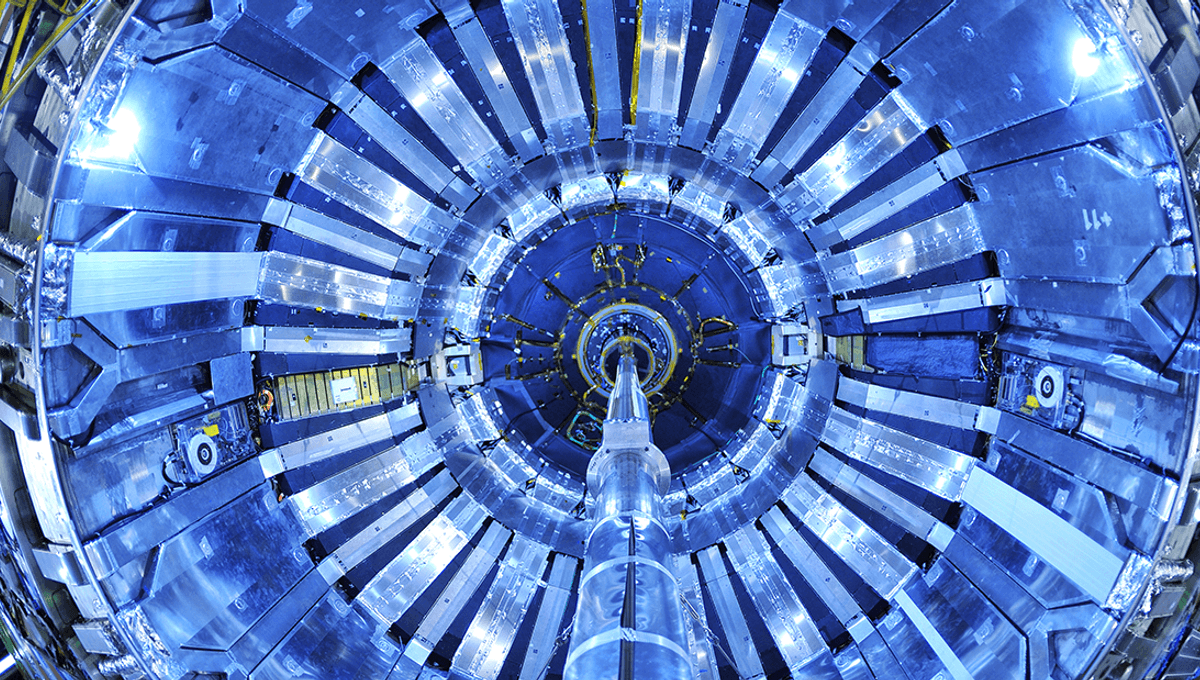
The Large Hadron Collider (LHC) has begun its first-ever collisions of oxygen ions, in the latest attempt to understand the early universe.
The LHC is largely famous for its proton-proton collisions, which ultimately led to the discovery of the Higgs boson and the Higgs field responsible for giving mass to elementary particles such as electrons, quarks, and other weak force bosons. But the LHC is also capable of colliding heavy ions, larger atoms, or molecules that have an electric charge by gaining or losing electrons.
When heavy ions are collided, it can produce a quark-gluon plasma (QGP), allowing us to learn about conditions in the early universe.
“For a few millionths of a second, shortly after the Big Bang, the universe was filled with an astonishingly hot, dense soup made of all kinds of particles moving at near light speed. This mixture was dominated by quarks – fundamental bits of matter – and by gluons, carriers of the strong force that normally ‘glue’ quarks together into familiar protons and neutrons and other species. In those first evanescent moments of extreme temperature, however, quarks and gluons were bound only weakly, free to move on their own in what’s called a quark-gluon plasma,” CERN explains.
“To recreate conditions similar to those of the very early universe, powerful accelerators make head-on collisions between massive ions, such as gold or lead nuclei. In these heavy-ion collisions the hundreds of protons and neutrons in two such nuclei smash into one another at energies of upwards of a few trillion electronvolts each. This forms a miniscule fireball in which everything ‘melts’ into a quark-gluon plasma.”
Generally, the LHC has stuck to colliding heavier ions of lead, containing 82 protons and 126 neutrons. But starting yesterday, scientists are colliding lighter ions together. Over the run, they will smash oxygen ions into oxygen ions, collide neon with neon, and protons with oxygen nuclei.
“These collision systems will let us investigate how the properties of the QGP emerge in relation to the system size,” Riccardo Longo, a physicist with the ATLAS heavy-ion group, explained in a statement. “While we understand the strong force well in ‘cold’ conditions, thanks to studies of proton–proton collisions, and in extremely hot and dense environments like lead–lead collisions, the question remains: what happens in between? We hope these lighter systems will let us connect the dots between the two.”
While physicists have an idea of what to expect, experiments like this can throw up plenty of surprises.
“At the moment there are only theories on how these systems should react at these energies,” Ivan Amos Cali, part of the CMS Heavy Ions group who will primarily study the collisions, said in a statement. “This is the first time we will actually get to see what happens – nobody has ever made this type of measurement!”
For example, when studying heavier ion collisions and xenon-xenon collisions, scientists at ATLAS saw “jet quenching”, as high-energy particles lose energy as they negotiate the quark-gluon plasma. Jet quenching was not seen in proton-lead collisions, which formed a smaller quark-gluon plasma system.
“Theory predicts we should see the onset of jet quenching in oxygen–oxygen collisions,” Longo added. “If we observe even modest suppression, it could pin down the critical system size at which jet quenching begins.”
Also of interest in these studies is the “collective flow” seen in the collective motion of particles that emerge from the quark-gluon plasma. Studying oxygen collisions could help tell us more about this collective behavior, whilst also telling us about the geometrical structure of oxygen nuclei. Meanwhile, colliding neon could tell us about its structure too, thought to be roughly in the shape of a bowling pin. The shape itself could have an impact on the formation of quark-gluon plasma.
“What’s even better is that the oxygen and neon runs will be right after one another,” Qipeng Hu, ATLAS Heavy Ion Physics Group convenor, added. “This adds incredible value to the datasets when we do our comparison, as they’ll have exactly the same experimental conditions.”
Though collisions are very much in the LHC’s wheelhouse, colliding lighter elements brings about new challenges, with the potential for “beam pollution”.
“This is a problem that we don’t face with proton beams, but with oxygen we experience what’s called the transmutation effect,” LHC ion specialist Roderik Bruce explained in a CERN statement. “Each collision creates secondary particles of the same charge-to-mass ratio as oxygen ions, polluting the beam and potentially making it complicated to analyse collisions. So, at some point, we might need to eject the beam and inject a new beam of pure oxygen, but the degree of transmutation is not yet known. The data analysis will tell us.”
The investigations will take place from July 1-9, with scientists aiming to get as much data as possible during the run.
Source Link: "Uncharted Waters": Large Hadron Collider Begins Colliding Oxygen For The First Time